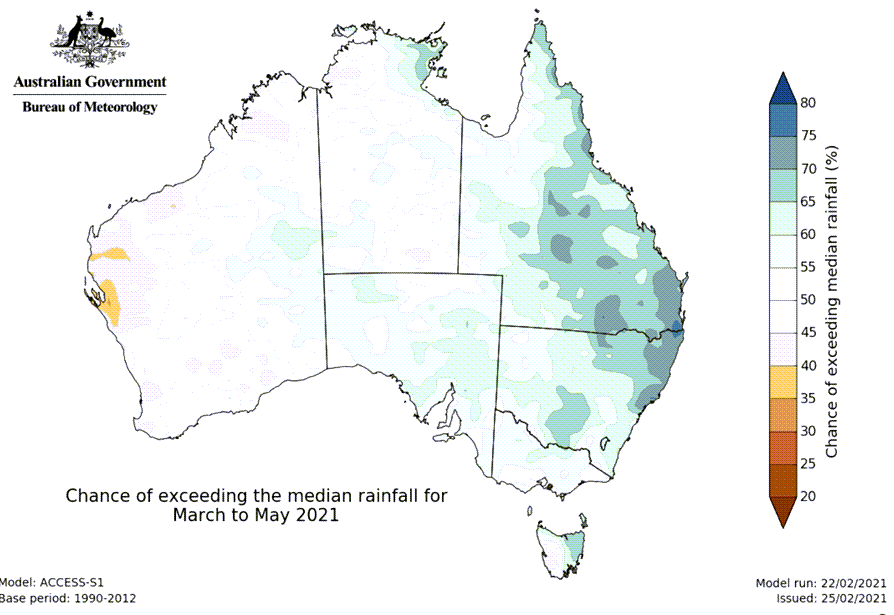Weather in Australia: what will autumn be like?
- Many parts of Australia are set for heavier than usual autumn rainfall
- Consequently, there’s an increased chance of flooding in some areas
- As well as increased rainfall, temperatures during the day and night are going to be mostly higher than the autumn average.
Over the coming months, we’ll see the tail end of the La Niña weather front in Australia (it comes to an end during autumn1) – but while it’s past its peak, the latest update from the Bureau of Meteorology (BOM) says it will continue to affect the weather patterns across much of the country2.
“The tropical Pacific Ocean is forecast to return to neutral conditions during autumn, consistent with the typical lifecycle of La Niña events,” says Dr Naomi Benger, climatologist at the BOM, in the BOM’s quarterly weather forecast.
“La Niña is in a decaying phase, but we expect its impacts to continue into autumn.
“These impacts include above-average rainfall for eastern and northern parts, and it also has an influence on the minimum temperature, keeping them above average.”
Increased flood risks for parts of Australia
Following on from what was the wettest summer for four years3, we can expect higher than average rainfall this autumn, with Arnhem Land in the Northern Territory, southern and eastern Queensland, most of New South Wales, eastern South Australia and eastern Tasmania having a 60 to 80 per cent chance of exceeding median rainfall4.
For the rest of the country – namely Western Australia, the majority of the NT, Victoria, western Queensland, South Australia and Tasmania – however, there’s no indication it will be anything other than average autumn rainfall5.

When higher than average rainfall is expected, it’s important to increase the frequency of maintenance around the home and business premises.
Clear gutters and downpipes regularly to ensure they can operate at maximum capacity and keep an eye on the weather forecast for the possibility of flash flooding.
David Gow, Head of Property Claims at QBE reiterates: “It’s always a good idea to think about ways to protect your home from the weather, and if we can expect more rain, you might also consider checking that your window and door seals are in good condition.”
In northern Australia, the BOM says that high soil-moisture levels will increase the risk of widespread flooding, while high and near-median streamflows are likely for most locations in eastern and northern Australia until April6.
If you’re in an area that’s prone to flooding, you can store anything in basements or garages on pallets or similar to minimise the potential for damage, while having sandbags at the ready is also a good mitigation strategy.
“Plus, if you know part of your property is low-lying, you might be susceptible to flooding. It’s a good idea to check for drainage issues so you can fix it now before heavy rain or flooding,” Gow added.
Warmer days and warmer nights
While the predicted rainfall is going to be heavier than it usually would be during a typical autumn, we’re going to have slightly higher than average temperatures.
The outlook predicts that warmer than average autumn days are distinctly possible in Tasmania, the southern regions of Victoria and South Australia, as well as the northern, north-western and far-western parts of Australia.
“There’s a neutral outlook elsewhere, except for the chance of below-average maximum temperatures for inland New South Wales,” reports Dr Benger.
Pockets of higher than average bushfire risk
While the vast majority of the country is set for average bushfire conditions over autumn, there are a few pockets or areas in central and southern Queensland, inland from the coast, that the Bushfire & Natural Hazards Cooperative Research Centre (BNHCRC) predict to have a higher than average risk of bushfire over the coming months.
According to the BNHCRC, the risk of grassfires and cropfires will continue over the coming months, particularly where rain has fallen to create good growing conditions7.
As we’ve seen already this year, bushfires can strike at any time and can cause devastation. It’s always a good idea to regularly maintain your property and surrounding area to reduce the ability of a bushfire to spread quickly.
Find out more about QBE’s home insurance and business insurance.
1 http://www.bom.gov.au/climate/outlooks/#/overview/summary
2 Australia in Autumn 2021 – Bureau of Meteorology
3 http://media.bom.gov.au/releases/810/la-nina-wanes-but-parts-of-australia-could-face-a-wetter-than-average-autumn/
4 http://www.bom.gov.au/climate/ahead/outlooks/archive/20210225-outlook.shtml
5 Australia in Autumn 2021 – Bureau of Meteorology
6 https://youtu.be/lf8W9HM5CNw
7 https://www.bnhcrc.com.au/news/2021/prescribed-burn-focus-fire-risk-changes-autumn









